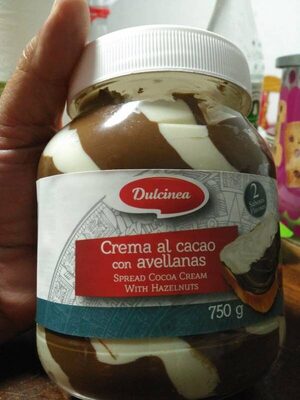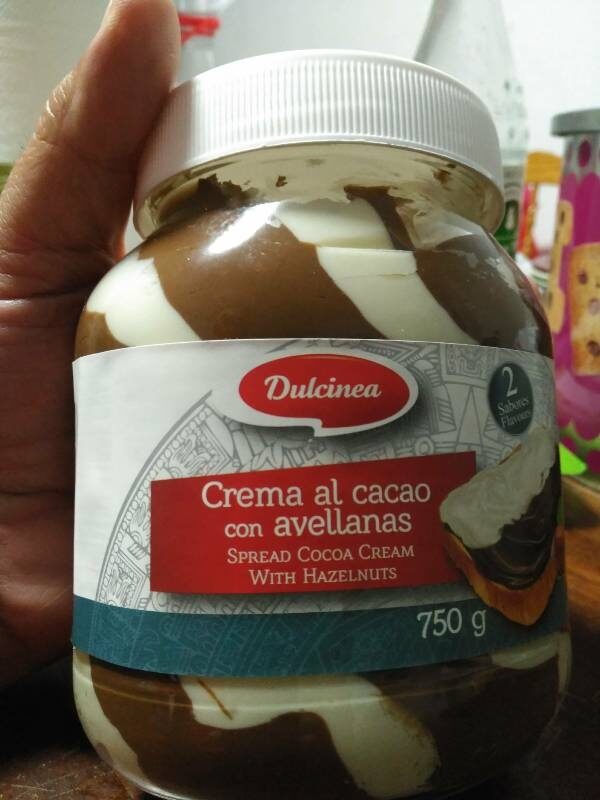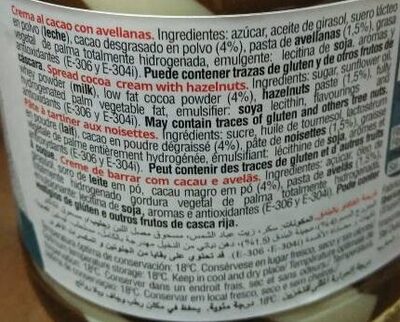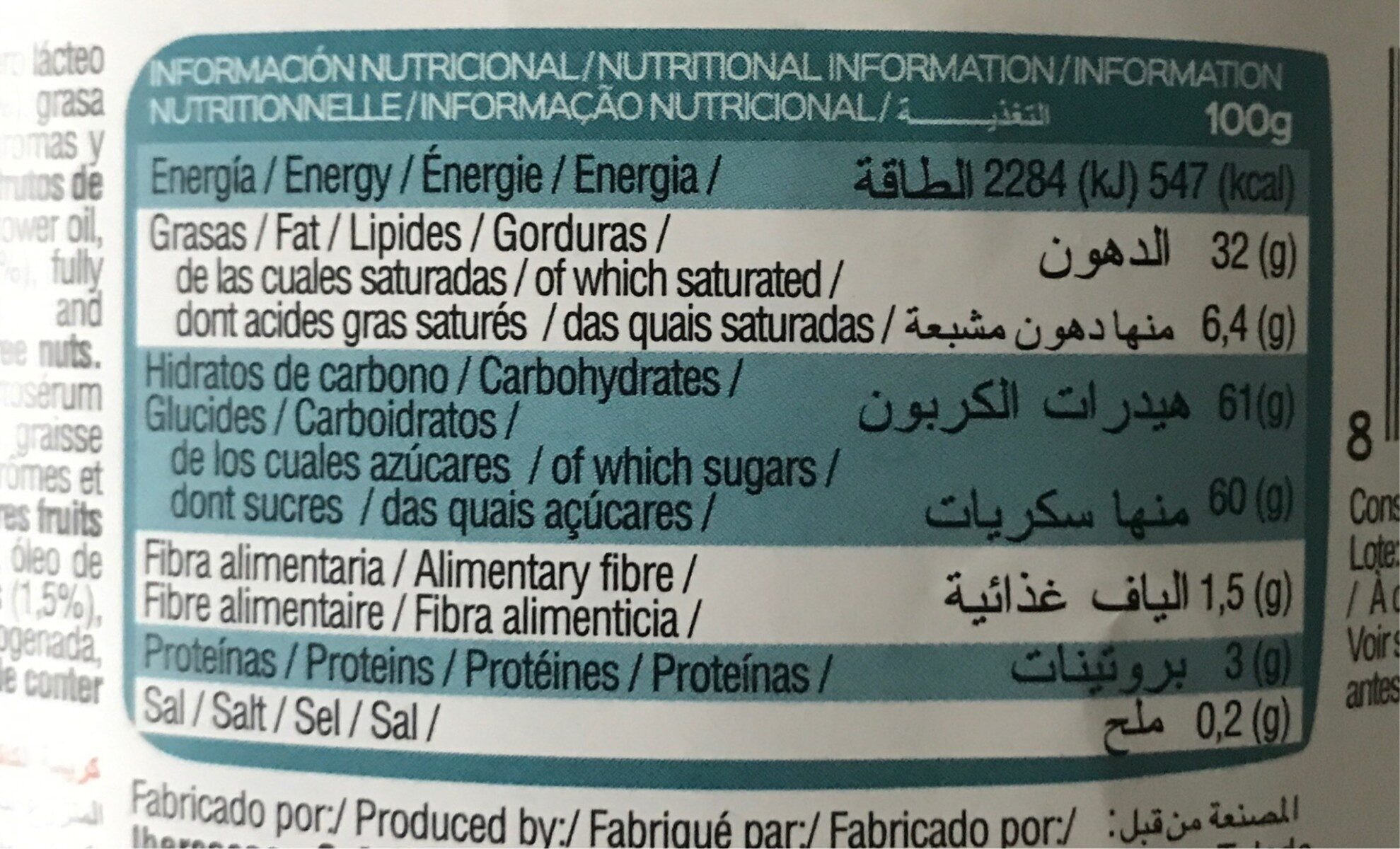Help us make food transparency the norm!
As a non-profit organization, we depend on your donations to continue informing consumers around the world about what they eat.
The food revolution starts with you!
Crema al cacao con avellanas - Dulcinea - 750 g
Crema al cacao con avellanas - Dulcinea - 750 g
This product page is not complete. You can help to complete it by editing it and adding more data from the photos we have, or by taking more photos using the app for Android or iPhone/iPad. Thank you!
×
Barcode: 8410510047341 (EAN / EAN-13)
Quantity: 750 g
Packaging: Plastic, Glass, Jar, es:Tapa
Brands: Dulcinea
Categories: Breakfasts, Spreads, Sweet spreads, fr:Pâtes à tartiner, Hazelnut spreads, Chocolate spreads, Cocoa and hazelnuts spreads
Labels, certifications, awards:
Green Dot
Countries where sold: Spain
Matching with your preferences
Health
Ingredients
-
12 ingredients
: Azúcar, aceite de girasol, suero lácteo en polvo (leche), cacao desgrasado en polvo 4 %, pasta de avellanas 1,5 %, grasa de palma totalmente hidrogenada, emulgente (lecitina de soja), aromas y antioxidantes (E-306, E-304i)Allergens: Milk, Nuts, SoybeansTraces: Gluten, Nuts
Food processing
-
Ultra processed foods
Elements that indicate the product is in the 4 - Ultra processed food and drink products group:
- Additive: E322 - Lecithins
- Ingredient: Emulsifier
- Ingredient: Flavouring
- Ingredient: Whey
Food products are classified into 4 groups according to their degree of processing:
- Unprocessed or minimally processed foods
- Processed culinary ingredients
- Processed foods
- Ultra processed foods
The determination of the group is based on the category of the product and on the ingredients it contains.
Additives
-
E304 - Fatty acid esters of ascorbic acid
Ascorbyl palmitate: Ascorbyl palmitate is an ester formed from ascorbic acid and palmitic acid creating a fat-soluble form of vitamin C. In addition to its use as a source of vitamin C, it is also used as an antioxidant food additive -E number E304-. It is approved for use as a food additive in the EU, the U.S., Canada, Australia, and New Zealand.Ascorbyl palmitate is known to be broken down -through the digestive process- into ascorbic acid and palmitic acid -a saturated fatty acid- before being absorbed into the bloodstream. Ascorbyl palmitate is also marketed as "vitamin C ester".Source: Wikipedia
-
E304i - Ascorbyl palmitate
Ascorbyl palmitate: Ascorbyl palmitate is an ester formed from ascorbic acid and palmitic acid creating a fat-soluble form of vitamin C. In addition to its use as a source of vitamin C, it is also used as an antioxidant food additive -E number E304-. It is approved for use as a food additive in the EU, the U.S., Canada, Australia, and New Zealand.Ascorbyl palmitate is known to be broken down -through the digestive process- into ascorbic acid and palmitic acid -a saturated fatty acid- before being absorbed into the bloodstream. Ascorbyl palmitate is also marketed as "vitamin C ester".Source: Wikipedia
-
E322 - Lecithins
Lecithins are natural compounds commonly used in the food industry as emulsifiers and stabilizers.
Extracted from sources like soybeans and eggs, lecithins consist of phospholipids that enhance the mixing of oil and water, ensuring smooth textures in various products like chocolates, dressings, and baked goods.
They do not present any known health risks.
-
E322i - Lecithin
Lecithins are natural compounds commonly used in the food industry as emulsifiers and stabilizers.
Extracted from sources like soybeans and eggs, lecithins consist of phospholipids that enhance the mixing of oil and water, ensuring smooth textures in various products like chocolates, dressings, and baked goods.
They do not present any known health risks.
Ingredients analysis
-
Palm oil
Ingredients that contain palm oil: Totally hydrogenated palm fat
-
Non-vegan
Non-vegan ingredients: Whey powder
-
Maybe vegetarian
Ingredients that may not be vegetarian: Whey powder, Flavouring
-
Details of the analysis of the ingredients
: Azúcar, aceite de girasol, suero lácteo en polvo, cacao desgrasado en polvo 4%, pasta de _avellanas_ 1.5%, grasa de palma totalmente hidrogenada, emulgente (lecitina de _soja_), aromas, antioxidantes (e306, e304i)- Azúcar -> en:sugar - vegan: yes - vegetarian: yes - ciqual_proxy_food_code: 31016 - percent_min: 11.75 - percent_max: 86.5
- aceite de girasol -> en:sunflower-oil - vegan: yes - vegetarian: yes - from_palm_oil: no - ciqual_food_code: 17440 - percent_min: 4 - percent_max: 45.25
- suero lácteo en polvo -> en:whey-powder - vegan: no - vegetarian: maybe - percent_min: 4 - percent_max: 31.5
- cacao desgrasado en polvo -> en:fat-reduced-cocoa-powder - vegan: yes - vegetarian: yes - ciqual_food_code: 18100 - percent_min: 4 - percent: 4 - percent_max: 4
- pasta de _avellanas_ -> en:hazelnut-paste - vegan: yes - vegetarian: yes - ciqual_food_code: 15004 - percent_min: 1.5 - percent: 1.5 - percent_max: 1.5
- grasa de palma totalmente hidrogenada -> en:totally-hydrogenated-palm-fat - vegan: yes - vegetarian: yes - from_palm_oil: yes - ciqual_proxy_food_code: 16129 - percent_min: 0 - percent_max: 1.5
- emulgente -> en:emulsifier - percent_min: 0 - percent_max: 1.5
- lecitina de _soja_ -> en:soya-lecithin - vegan: yes - vegetarian: yes - ciqual_food_code: 42200 - percent_min: 0 - percent_max: 1.5
- aromas -> en:flavouring - vegan: maybe - vegetarian: maybe - percent_min: 0 - percent_max: 1.5
- antioxidantes -> en:antioxidant - percent_min: 0 - percent_max: 1.5
- e306 -> en:e306 - vegan: yes - vegetarian: yes - percent_min: 0 - percent_max: 1.5
- e304i -> en:e304i - vegan: yes - vegetarian: yes - from_palm_oil: maybe - percent_min: 0 - percent_max: 0.75
Nutrition
-
Bad nutritional quality
⚠ ️Warning: the amount of fruits, vegetables and nuts is not specified on the label, it was estimated from the list of ingredients: 1This product is not considered a beverage for the calculation of the Nutri-Score.
Positive points: 1
- Proteins: 1 / 5 (value: 3, rounded value: 3)
- Fiber: 1 / 5 (value: 1.5, rounded value: 1.5)
- Fruits, vegetables, nuts, and colza/walnut/olive oils: 0 / 5 (value: 1.5, rounded value: 1.5)
Negative points: 22
- Energy: 6 / 10 (value: 2284, rounded value: 2284)
- Sugars: 10 / 10 (value: 60, rounded value: 60)
- Saturated fat: 6 / 10 (value: 6.4, rounded value: 6.4)
- Sodium: 0 / 10 (value: 80, rounded value: 80)
The points for proteins are not counted because the negative points are greater or equal to 11.
Nutritional score: (22 - 1)
Nutri-Score:
-
Nutrient levels
-
Fat in high quantity (32%)
What you need to know- A high consumption of fat, especially saturated fats, can raise cholesterol, which increases the risk of heart diseases.
Recommendation: Limit the consumption of fat and saturated fat- Choose products with lower fat and saturated fat content.
-
Saturated fat in high quantity (6.4%)
What you need to know- A high consumption of fat, especially saturated fats, can raise cholesterol, which increases the risk of heart diseases.
Recommendation: Limit the consumption of fat and saturated fat- Choose products with lower fat and saturated fat content.
-
Sugars in high quantity (60%)
What you need to know- A high consumption of sugar can cause weight gain and tooth decay. It also augments the risk of type 2 diabetes and cardio-vascular diseases.
Recommendation: Limit the consumption of sugar and sugary drinks- Sugary drinks (such as sodas, fruit beverages, and fruit juices and nectars) should be limited as much as possible (no more than 1 glass a day).
- Choose products with lower sugar content and reduce the consumption of products with added sugars.
-
Salt in low quantity (0.2%)
What you need to know- A high consumption of salt (or sodium) can cause raised blood pressure, which can increase the risk of heart disease and stroke.
- Many people who have high blood pressure do not know it, as there are often no symptoms.
- Most people consume too much salt (on average 9 to 12 grams per day), around twice the recommended maximum level of intake.
Recommendation: Limit the consumption of salt and salted food- Reduce the quantity of salt used when cooking, and don't salt again at the table.
- Limit the consumption of salty snacks and choose products with lower salt content.
-
-
Nutrition facts
Nutrition facts As sold
for 100 g / 100 mlCompared to: Cocoa and hazelnuts spreads Energy 2,284 kj
(547 kcal)- Fat 32 g -6% Saturated fat 6.4 g -12% Carbohydrates 61 g +18% Sugars 60 g +28% Fiber 1.5 g -61% Proteins 3 g -54% Salt 0.2 g +90% Fruits‚ vegetables‚ nuts and rapeseed‚ walnut and olive oils (estimate from ingredients list analysis) 1.5 %
Environment
-
Eco-Score D - High environmental impact
⚠ ️Select a country in order to include the full impact of transportation.The Eco-Score is an experimental score that summarizes the environmental impacts of food products.→ The Eco-Score was initially developped for France and it is being extended to other European countries. The Eco-Score formula is subject to change as it is regularly improved to make it more precise and better suited to each country.Life cycle analysis
-
Average impact of products of the same category: C (Score: 50/100)
Category: Chocolate spread with hazelnuts
Category: Chocolate spread with hazelnuts
- PEF environmental score: 0.55 (the lower the score, the lower the impact)
- including impact on climate change: 7.67 kg CO2 eq/kg of product
Stage Impact Agriculture
48.4 %Processing
44.4 %Packaging
3.4 %Transportation
2.9 %Distribution
0.9 %Consumption
0.0 %
Bonuses and maluses
-
Missing origins of ingredients information
Malus: -5
⚠ ️ The origins of the ingredients of this product are not indicated.
If they are indicated on the packaging, you can modify the product sheet and add them.
If you are the manufacturer of this product, you can send us the information with our free platform for producers.
-
Ingredients that threatens species
Malus: -10
Contains palm oil
Tropical forests in Asia, Africa and Latin America are destroyed to create and expand oil palm tree plantations. The deforestation contributes to climate change, and it endangers species such as the orangutan, the pigmy elephant and the Sumatran rhino.
-
Packaging with a medium impact
Malus: -12
Shape Material Recycling Impact Jar Plastic High Unknown Glass Low ⚠ ️ The information about the packaging of this product is not sufficiently precise (exact shapes and materials of all components of the packaging).⚠ ️ For a more precise calculation of the Eco-Score, you can modify the product page and add them.
If you are the manufacturer of this product, you can send us the information with our free platform for producers.
Eco-Score for this product
-
Impact for this product: D (Score: 23/100)
Product: Crema al cacao con avellanas - Dulcinea - 750 g
Life cycle analysis score: 50
Sum of bonuses and maluses: -27
Final score: 23/100
-
Carbon footprint
-
Equal to driving 4.0 km in a petrol car
767 g CO² per 100g of product
The carbon emission figure comes from ADEME's Agribalyse database, for the category: Chocolate spread with hazelnuts (Source: ADEME Agribalyse Database)
Stage Impact Agriculture
35.8 %Processing
59.4 %Packaging
2.2 %Transportation
2.3 %Distribution
0.2 %Consumption
0.0 %
Packaging
-
Packaging with a medium impact
-
Packaging parts
Jar (Plastic)
(Glass)
-
Packaging materials
Material % Packaging weight Packaging weight per 100 g of product Plastic Glass Total
-
Transportation
-
Origins of ingredients
Missing origins of ingredients information
⚠ ️ The origins of the ingredients of this product are not indicated.
If they are indicated on the packaging, you can modify the product sheet and add them.
If you are the manufacturer of this product, you can send us the information with our free platform for producers.Add the origins of ingredients for this product Add the origins of ingredients for this product
Threatened species
-
Contains palm oil
Drives deforestation and threatens species such as the orangutan
Tropical forests in Asia, Africa and Latin America are destroyed to create and expand oil palm tree plantations. The deforestation contributes to climate change, and it endangers species such as the orangutan, the pigmy elephant and the Sumatran rhino.
Report a problem
-
Incomplete or incorrect information?
Category, labels, ingredients, allergens, nutritional information, photos etc.
If the information does not match the information on the packaging, please complete or correct it. Open Food Facts is a collaborative database, and every contribution is useful for all.
Data sources
Product added on by elcoco
Last edit of product page on by tasja.
Product page also edited by allergies-app-chakib, elcoco.574064a194adf4a779f7c76c8b15dc3f, kiliweb, openfoodfacts-contributors, torredibabele, yuka.WktRRk9iMHpxdlpYcHNNUjRoUFR3TkFyLzZHRGVFYU1Gc2NBSWc9PQ.










